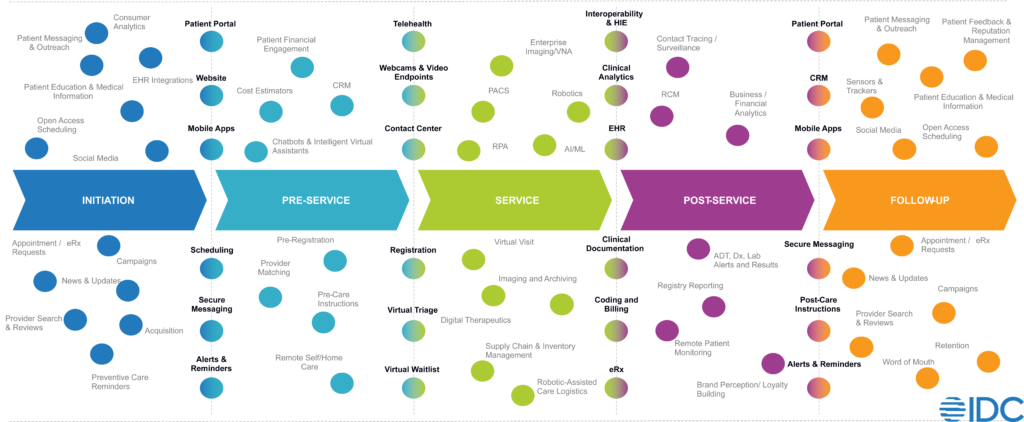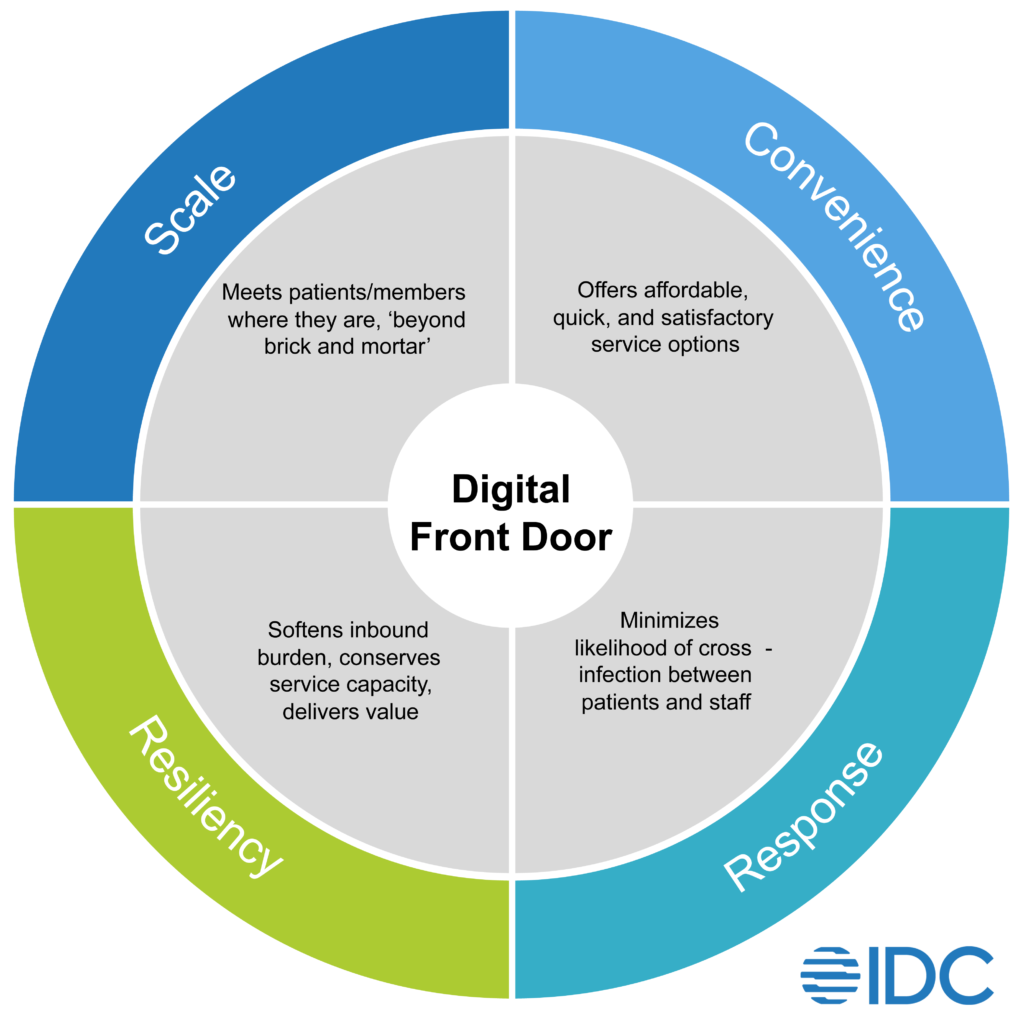Two years of healthcare digital transformation (DX) got accomplished during the first two months of the COVID-19 pandemic. IDC survey data collected during the initial pandemic wave showed that 93.5% of healthcare organizations were still investing in DX initiatives to close technology gaps (41.4%), mitigate the impact of the recession (21.5%), take more market share (15.9%), and introduce disruptive new business models (14.7%). Also, IDC data showed 83.9% of some 1,500 U.S. survey respondents who had a care visit during that time as having a virtual visit for the first time, where 1 of 5 respondents downloaded a virtual care application in advance of needing it, and 72.5% used a front-end conversational AI chatbot or symptom checker.
The data shows that healthcare digital transformation (DX) is no longer ignored. Instead, healthcare can digitally transform, is transforming rapidly, and needs to transform continuously to survive any future disruptions – especially when considering the long list of digital era stress tests and mounting pressures the industry faces (e.g., vaccine administration, aging populations, more chronic conditions, the shift to value-based care, the rise of consumerism, and increased cyber threats). Achieving digital resiliency in healthcare is vital and will separate the thrivers from survivors.
Catalyzing the Inevitable
Since its origins, the center of the healthcare universe concentrated on the doctor and paternalistic relationships they had with patients. Use cases, like the digital front door, are gravitating the pull and accelerating the pace that the healthcare universe takes toward a more consumer-friendly, patient-centric paradigm where doctors are still relevant but patients, as relevant, empowered by technology. To learn more about the digital front door, read the new IDC eBook. Additionally, IDC predicts that by 2023, 65% of patients will have accessed care through a digital front door as healthcare providers look for better ways to improve access, engagements, and experiences across all services.
There are many interpretations about what a digital front door is in healthcare, depending on whom you ask. IDC defines the digital front door as “all the touchpoints where providers and payers can digitally interact with patients or members to drive better access, engagement, and experiences across the service continuum.” The emphasis on access, engagement, and experiences signals a detachment from the old ways of doing things. As a pandemic-driven use case, the digital front door focuses on scaling service capacity beyond the physical walls of a healthcare facility or system through virtual and digital technologies and capabilities to generate less costly, more rapid, and satisfactory responses to demand.
Planning with the End in Mind
The digital front door is not a front-end initiative that points individuals to the service (e.g., via open-access scheduling or telehealth). Instead, the digital front door combines a vast array of technologies and capabilities into a unified vehicle, fabric, or layer that spans across the service to meet the person where they are – from when an individual realizes a need to get care, through the various stages of the service, and beyond.

Consider a day in the life of a provider organization with a robust digital front door in place. One of its patients starts to feel cold or flu-like symptoms. The provider will have already been engaging with the patient through messaging and outreach campaigns about the relevance of such symptoms in the COVID-19 pandemic or through other updates such as on social media. The patient uses the provider’s open-access scheduling solution on their patient portal, website, or dedicated mobile application to book an appointment to get seen. Before the patient gets seen, they interact with a chatbot symptom checker that completes the pre-registration process and shares pre-care instructions and an estimate of costs for the visit.
The pre-service workflow leads the patient to the service. The patient gets virtually registered, checked in, and seen initially through an AI-enabled virtual triage or asynchronous care automation tool. The patient is then placed into a virtual waiting room and seen by their doctor through an EHR-based telehealth integration that enables a virtual visit. They both use webcam-enabled video endpoints to interact through the solution. The doctor completes their clinical documentation and coding for billing through their EHR/RCM solution, and the patient gets diagnosed as only having a cold. The doctor ends the visit, and the patient’s information gets routed into a contact tracing tool for disease surveillance depending on privacy laws and public health guidelines at the local, regional, state, or federal level.
In the post-service stage, the patient receives automated post-care instructions. The patient learns about how to take care of their cold and what to continue to look out for in the case of COVID-19 symptoms, updates on how to get the vaccine, and where they can leave a review about their care experience. Now, consider all that was described in this entire example. You will notice that the patient did not take a single step into a physical office, hospital, etc. This was a digital front door, an end-to-end journey that scaled and virtualized care from doctor to patient through multiple digital touchpoints.
Digital Transformation Unleashed and Redefined
The digital front door is a transformative opportunity and gateway for enabling digital-first health experiences. The benefits are that the digital front door scales the service to meet the patient where they are. With that, it delivers value beyond physical walls or brick-and-mortar. Costs become more affordable, and the resource burden decreases for clinicians (and patients) due to the care process being digital and virtual rather than physical. As physical service capacity is conserved, resiliency gets infused as the provider softens any inbound burden that would have resulted from the cumulative effect of patients seen in-person and who could have been seen virtually. In a pandemic wave and against surging case numbers, this sort of initiative can significantly contain and decrease the risk of infection by minimizing the likelihood for cross-infection between patients and staff, if not eliminating it altogether.

Healthcare leaders need to understand that it is one thing to digitally interact with a person and an entirely different thing to digitally impact them. It is the difference between engaging with a person versus engaging, acquiring or retaining, and earning their loyalty over the long term. Leaders need to understand the person at the heart of the experience and consider everything from their clinical and non-clinical data to the subtleties in differences between care-seeking consumers ‘shopping for care’ (i.e., to become a new patient) and existing patients ‘arranging for care.’ An effective digital front door will be shaped by the voices of decision-makers seated at the roundtable and those of consumers and patients as well. All voices need to make it onto the drawing board. This approach will ensure that a digital front door is relevant, meaningful, impactful, and meets its clinical, business, IT, and social needs.
Finally, a digital front door must always go beyond the front-end to become a holistic, cross-cutting, end-to-end health IT endeavor. The digital front door offers a new bedrock for shared data, insights, applications, operations, and expertise in healthcare. Health IT suppliers should look at such initiatives as an opportunity to go to market with new and improved solution offerings centered on infusing digital resiliency across the service to carve out a niche to differentiate in, while buyers (i.e., providers and payers) should look at it as an opportunity to pivot toward a better level of competitiveness and future-readiness in the journey toward the next normal. In fact, we dive deeper into this in an upcoming webinar. Join Mutaz Shegewi, Research Director, Worldwide Provider IT Transformation Strategies, on a journey to understanding the digital front door, the technologies and capabilities that contribute to it, industry examples, best practices and how this all impacts individual health experiences now and in the future for the webinar, The Digital Front Door, live on June 15th at 11 AM/ET.




